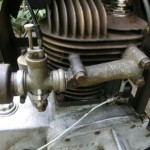Home › Forums › The Machinery Forums › Pedestrian operated machines › Flywheell & Fan removal for Villiers Mk7
- This topic has 9 replies, 3 voices, and was last updated 5 years, 5 months ago by
 wristpin.
wristpin.
-
AuthorPosts
-
October 30, 2018 at 9:34 am #29541
 vhgmcbuddyMember
vhgmcbuddyMemberHi All, I need to remove the flywheel / fan from a Villiers Mk7 engine. So far have removed the bolt and washer and taken off the pulley. Now I’ve got a hex nut holding the flywheel on which won’t undo because there seems to be a circlip deep in and hard to get at. Is this stopping the removal or is the nut just tight? I’ve seen conflicting stuff online but most seems to be saying undoing the nut should self-pull the flywheel off. I don’t want to give it some real force in case something breaks. Advice please on how to properly get the flywheel off. Many thanks, Mick
October 30, 2018 at 10:07 am #29543 wristpinParticipant
wristpinParticipantThat’s as it should be, the nut is captive to exert a force on the flywheel to pull it off the taper on the crank. Villiers provided a special spanner designed to be struck with a hammer both to remove and, equally important, to tighten it sufficiently to maintain the flywheels position on the crank to preserve the timing – there’s no key to position it.
October 30, 2018 at 12:19 pm #29544 trusty220Keymaster
trusty220KeymasterYou will need to exert quite a bit of force to unstick the taper, that’s why the nut was designed in the way that it was. Don’t try it with an open ended spanner because you will just round off the hexagon. If you can get a hexagonal socket that will be the best way because it drives off the flat faces, whereas a 12-point socket or ring spanner only drives off the tips of the points and is more likely to round off the hexagon again.
Good luck with it.
October 30, 2018 at 5:03 pm #29545 vhgmcbuddyMember
vhgmcbuddyMemberHi Wristpin, Thanks for the info, yet again! I’ll mark up the flywheel and crank before undoing the nut so as to reset the timing correctly. Will have a bash (literally) at it when I’ve found a hex spanner that fits properly. Cheers, Mick
October 30, 2018 at 5:06 pm #29546 vhgmcbuddyMember
vhgmcbuddyMemberHi Trusty, Thanks for the info. As per reply to Wristpin I’ll have a bash at it when I’ve found a hex spanner that fits properly. Cheers, Mick
October 30, 2018 at 9:05 pm #29547 wristpinParticipant
wristpinParticipantI’ll mark up the flywheel and crank before undoing the nut
You may find that Villiers have done that job for you. At some point in production they used to set the timing using basics such as piston position and points opening and then rotated the crank to Top Dead Centre and stamped an arrow on the flywheel rim to coincide with another reference mark on the flywheel housing back plate. If you are fortunate enough to have one of those engines, all you have to do is to clean and set the points to the correct gap (12 – 15 thou),turn the crank so that the piston is at TDC (probably best to remove the head to do this rather than at an angle through the plug hole), and fit the flywheel so that the arrow aligns with the mark.
The slight danger in making your own markings is that unless you are 100% sure that the “as is” timing and points gap are correct, you are just perpetuating a possible inaccuracy.
At the end of the day, if you have to re-time the engine by relating the piston position to the point at which the points start to open, it is not rocket science and one of us will talk you through it.
I totally endorse Trusty220’s advice not to use a open ended spanner on the flywheel nut and that a stout single hex socket or box spanner is the way to go, but if all else fails an old cranked Whitworth ring spanner is unlikely to harm the nut – but it must be the correct size of Whitworth spanner and not the nearest AF or metric! The correct “flogging/slogging” spanner is still available from Villiers Services for around £20 delivered.
villiersservices.co.ukOctober 31, 2018 at 9:12 am #29550 wristpinParticipant
wristpinParticipantThis single hex box spanner is available from L&S but CHECK the size as they only mention the larger engines
October 31, 2018 at 9:27 am #29551 vhgmcbuddyMember
vhgmcbuddyMemberHi Wristpin, Many thanks for helping out someone who’s very much still wearing L plates with his first mower. I had a more careful look at the flywheel last night and there’s punched dots on the flywheel and the back plate that I hadn’t noticed previously. Took the head off to be sure and they correspond to TDC. Phew! Hopefully that will make cleaning, checking* & refitting the ignition parts easier and for an accurate set up. So will sort through a toolbox full of rusty “vintage” spanners in my Dad’s garage at the weekend. I suspect (hope!) there are some Whits in there and one of the right size. Failing that I’ll invest some £££ in acquiring one. Once again many thanks. Cheers, Mick
* I’ve just read your posts on getting the coil checked properly rather than just doing a resistance check. I am getting a spark and the engine has run but it’s difficult to start so I’ll just clean, set and make sure it’s fuelling first. I’ll get it tested if still problematic and the stripping & refitting will be good practice.October 31, 2018 at 9:39 am #29552 vhgmcbuddyMember
vhgmcbuddyMemberHi Wristpin, Thanks. Just seen your post re box spanner and it reminded me I’ve got a few I inherited somewhere. Just where? Also, a chap I volunteer with at the National Trust races 1960’s Formula Fords so should source one there, plus he’s currently got my welding mask on loan so owes me a favour. Cheers, Mick
October 31, 2018 at 2:37 pm #29555 wristpinParticipant
wristpinParticipantSounds as though someone has saved you some fiddling around resetting the timing from scratch, cross fingers that the punch marks are in the right place. I concur with the the suggestion of having the coil checked out on a proper tester – even more so for the condenser: judging from the number that I replace after a dodgy test result it’s well worth doing. The problem may be finding someone with the right kit to do it – used to be essential in any small engine workshop but since the introduction of electronic systems it’s just chuck it and fit another!
I work on a lot of “unknown” small engines and nearly always start with a “top end” overhaul – aka a “valve job”, but there again I have the kit to do it. A lot of people spend ages fiddling with carburettion and ignition when the root cause of poof starting and running is out of adjustment and poorly seating valves. -
AuthorPosts
- You must be logged in to reply to this topic.

